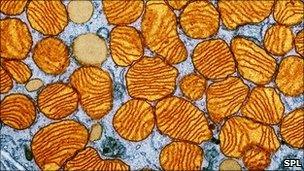New fertility technique to be assessed by regulator
- Published

Mitochondria provide the energy cells need to function
Health Secretary Andrew Lansley has asked the Human Fertilisation and Embryology Authority to assess a controversial fertility treatment.
The "three-parent IVF" technique developed at Newcastle University involves the transfer of human genetic material between two fertilised eggs.
It could offer couples at risk of passing on serious inherited disorders a way to have a healthy child.
New legislation would be needed to allow the technique to be used.
The Newcastle University team published research last year outlining how the technique, which is aimed at helping couples affected by potentially devastating mitochondrial diseases to have healthy children, worked.
Mitochondria are found in every cell in the human body and provide the energy cells need to function.
Ethical concerns
But because mitochondrial DNA is only passed down the female line, and is not present in the nucleus of a fertilised human egg, it is possible to extract the nucleus and transplant it into a second, donor egg.
The resulting embryo has the nuclear DNA of the mother and father, but the mitochondrial DNA of the donor.
The amount of genetic material contained in mitochondrial DNA is very small - just 13 protein-producing genes compared to the 23,000 genes inherited from parents.
But even this limited genetic relationship to a "third parent" has raised ethical concerns.
David King, head of Human Genetics Alert, said: "The more you manipulate embryos, the more risk there is."
The researchers say they are far from ready to use the technique on patients but that because the science is progressing "very rapidly", the review of the process, which would inform political debate, needs to start now.
Alison Murdoch, head of the department of reproductive medicine at Newcastle University said she anticipated the review process could take about a year.
She added: "As doctors we have a duty to treat disease and where possible to prevent disease.
"With diseases for which there are no treatments the imperative to develop new treatments is even greater.
"Of course no treatment is ever risk free and if there are risks we will need to quantify these so that doctors can discuss the relative risks and benefits with patients and their families."
The HFEA panel is set to submit its report to the government next month.
A Department of Health spokeswoman said: "This treatment is not currently possible under current legislation.
"When the group reports back and based on the evidence available, we can decide whether it is the right time to consider making these regulations."